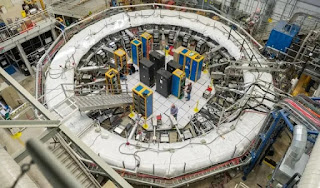The findings are based on an earlier experiment in 2021, which generated four times the data with the experimental uncertainty cut in half. If these results hold true and the theoretical disputes related to these measurements are settled, this experiment could mark a major breakthrough in physics, challenging the prevailing theory explaining subatomic particles for over five decades.
In essence, the muon’s minute oscillation, also known as a magnetic moment, could potentially unsettle the very foundations of science.
“We are venturing into uncharted territory,” says Brendan Casey, a senior scientist at Fermilab involved in the Muon g-2 experiment. “We are assessing the muon’s magnetic moment with unprecedented precision.”
Muons, frequently termed "fat electrons," bear similarities to electrons but are 200 times heavier and radioactive unstable, decaying into electrons and tiny, uncharged particles called neutrinos within microseconds. Muons possess a characteristic called spin, which causes them to act like miniature magnets and oscillate like tiny gyros in a magnetic field.
Fermilab physicists propelled these particles near the speed of light around a supercool magnetic ring to study muon oscillation. This high speed extends the muons' brief lifespan by about 3,000 times due to relativistic time dilation.
By tracking the oscillations of the muons as they circled the 50-foot-wide ring thousands of times, the physicists gathered data suggesting the muon oscillated more than anticipated.
The scientists involved in the study suggest that this could be the result of a previously unaccounted-for phenomenon not explained by the Standard Model, which outlines all subatomic particles and has remained unchanged since the mid-1970s.
This enigmatic phenomenon could be an entirely unknown force of nature (in addition to the four known forces: gravitational, electromagnetic, and strong and weak nuclear forces), an undiscovered exotic particle, evidence of a new dimension, or an unknown facet of space-time.
Regardless of its nature, the data implies that something unknown is influencing the muons within the ring.
However, full confirmation will require more time. To ensure accuracy, the physicists will utilize all the data gathered during the G-2 experiment conducted from 2018 to 2023. The current result only uses data from 2019 and 2020. Additionally, they will need to wait for theoretical predictions from the Standard Model.
Currently, two theoretical methods used to calculate the expected muon oscillation according to the Standard Model yield contradictory predictions. Some of these calculations, including one published the same week as the 2021 G-2 experiment results, assign a much larger value to the theoretical uncertainty of the muon's magnetic moment, potentially negating the experiment's revolutionary implications for physics.
Another experiment using data from the CMD-3 accelerator in Novosibirsk, Russia, also appears to show muons oscillating within normal limits. However, this contradicts an earlier accelerator run suggesting an opposite result.
Fermilab researchers anticipate that the full results, expected to be ready by 2025, will be precise enough to provide a conclusive reading.
Source: Physical Review Letters


Post a Comment